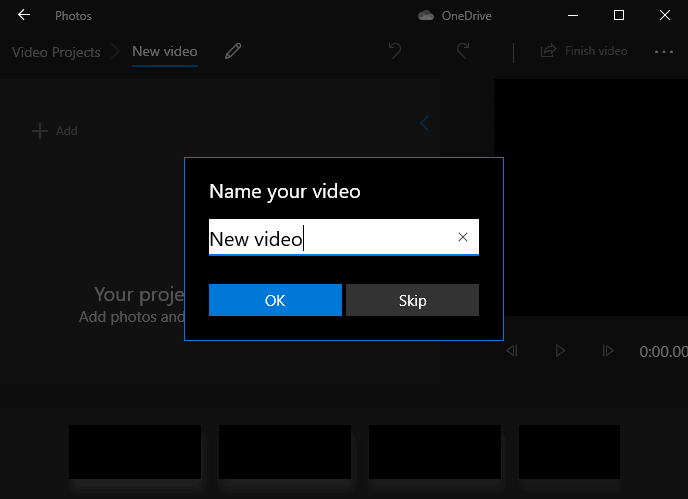-
![]()
Sofia Albert
Sofia has been involved with tech ever since she joined the EaseUS editor team in March 2011 and now she is a senior website editor. She is good at solving various issues, such as video downloading and recording.…Read full bio -
![]()
Alin
Alin is a sophisticated editor for EaseUS in tech blog writing. She is proficient in writing articles related to screen recording, voice changing, and PDF file editing. She also wrote blogs about data recovery, disk partitioning, data backup, etc.…Read full bio -
Jean has been working as a professional website editor for quite a long time. Her articles focus on topics of computer backup, data security tips, data recovery, and disk partitioning. Also, she writes many guides and tutorials on PC hardware & software troubleshooting. She keeps two lovely parrots and likes making vlogs of pets. With experience in video recording and video editing, she starts writing blogs on multimedia topics now.…Read full bio
-
![]()
Gorilla
Gorilla joined EaseUS in 2022. As a smartphone lover, she stays on top of Android unlocking skills and iOS troubleshooting tips. In addition, she also devotes herself to data recovery and transfer issues.…Read full bio -
![]()
Rel
Rel has always maintained a strong curiosity about the computer field and is committed to the research of the most efficient and practical computer problem solutions.…Read full bio -
![]()
Dawn Tang
Dawn Tang is a seasoned professional with a year-long record of crafting informative Backup & Recovery articles. Currently, she's channeling her expertise into the world of video editing software, embodying adaptability and a passion for mastering new digital domains.…Read full bio -
![]()
Sasha
Sasha is a girl who enjoys researching various electronic products and is dedicated to helping readers solve a wide range of technology-related issues. On EaseUS, she excels at providing readers with concise solutions in audio and video editing.…Read full bio
Page Table of Contents
0 Views |
0 min read
Key Takeaways
Enable Windows text to speech on your Windows computer by going to "Settings" > "Ease of Access" > "Narrator" (Windows 10) or "Settings" > "Accessibility" > "Narrator"(Windows 11).
Very few people know that Windows OS has text-to-speech built into it, similar to the Siri text-to-speech. Windows comes with a proprietary text-to-speech app called Narrator that describes what's on your screen. The Windows text-to-speech features allow you to read the text on the screen aloud and navigate through apps, webpages, and more. Let us learn how to set up and use this accessibility tool of Windows.
How to Turn on Windows Text-to-Speech
The Windows Narrator is switched off by default, and you have to trigger it to start. You can use the "Windows logo key" + "Ctrl" + "Enter" to turn it on or access it using Settings.
Step 1. Press "Windows + I " to open the "Settings."
Step 2. Go to the "Accessibility" section on Windows 11 and the "Ease of Access" section on Windows 10.
Step 3. Turn on the toggle to enable the Narrator on your PC.

Step 4. You will see a Narrator's dialog box speaking out the window's contents to explain what the Narrator is about. You can also see a blue outline highlighting the content the Narrator is reading.
Step 5. To stop the narration, you can click on "OK" at the bottom. Do not forget to uncheck the "Don't show again" button, as the window narration happens every time you start the Narrator.

Step 6. As soon as you close the narration window, a welcome screen appears after staring at the Narrator. It's a guide to help you understand what the Narrator is about, how to use it, and its related content to use it on your device.

How to Set up Text-to-Speech on PC
Once you have enabled Windows Text to Speech, the next step is to set up the feature according to your needs and know the basic shortcuts to handle it using the keyboard.
Access the Start-up Options under Use Narrator
The top section, Use Narrator, contains a few start-up options about how the programs get activated.

- Start Narrator after sign-in: This option starts the Narrator right after you sign in with your Windows account.
- Start Narrator before sign-in: This allows you to invoke the Narrator without logging in.
- The keyboard shortcuts for Narrator: As we have discussed, you can start and stop the Narrator with the keyboard shortcut Windows Key + Ctrl + Enter.
- Show Narrator Home when Narrator starts: This action opens up the Narrator welcome screen as soon as you start the program.
Now, to personalize the Narrator voice, scroll down a bit to the Narrator's voice section. Here, you can find a few settings and shortcuts to change voice and adjust the voice parameters.
You can customize the voice of the narrator with seven different voices according to various countries. Additionally, you can change the voice's speech, pitch, and volume. If you wish to add your custom voice, add natural voices and use it.

The default language on Narrator is English, but it allows us to add various languages. Navigate to "Time & language" > "Speech" to add text to speech voices. Windows Speech has 48 native languages for the users to add.

Windows Text to Speech provides Narrator shortcuts to control the voice playback:
- "Narrator"+ "Ctrl"+ "+": To increase the Narrator's volume.
- "Narrator" + "Ctrl" + "-": To decrease the volume of the Narrator.
- "Narrator" + "+" or Narrator + "-": To speed up or slow the voice playback.
Furthermore, you can adjust the verbosity settings if you wish to add more detail to Narrato's speech. Numerous settings include pausing while reading punctuation, emphasizing formatted text, changing the tone when reading capitalized text, context levels for buttons and controls, and more. In fact, with verbosity, you can make the Narrator announce what you type in real-time.

How to Use Text-to-Speech on Windows 10/11
Once you know how to enable the Narrator and set it up, you must know how to read the text on the screen. The Narrator can do many things: read the text on the screen, navigate across content and tabs, or use the Scan mode to give more control over what to read.
Here is a list of shortcuts you can follow along with the Narrator modifies key for the screen reader:
- To read the current page content: "Narrator" + "Ctrl" + "I"
- To read the current paragraph content: "Narrator" + "Ctrl" + "K"
- To read the current line content: "Narrator" +" I"
- To read the current sentence content: "Narrator" + "Ctrl" + "Comma"
- To read the current word content: "Narrator" + "K"
- To read the current character content: "Narrator" + "Comma"
- To read the current location content: "Narrator" + "Tab"
- To stop reading the content: "Ctrl"
- To navigate out of the content: "Tab"
Let us see how we can use the Narrator to navigate between interactive controls like links, buttons, and checkboxes. The tab and arrow keys help you make these jumps.
- If you have a hyperlink on your web pages, navigate to it using the arrow keys and tab, and press "Enter" to access the link.
- To find out more about the image or a link, go to the image or link and press "Narrator" + "Ctrl" + "D" to preview the title and description.
- Similarly, you should know how to make Google Docs to read to you.
How to Get Google Docs to Read to You
Unlock the Power of Your Google Docs! Learn How to Make Google Docs Read Aloud on Windows, Mac, Chromebook, and Phone. Listen and Learn in Just a Click!

Advanced Navigation with Scan Mode
Narrator comes with a Scan mode that helps you work through the page's contents with Up and Down arrows. Use the "Caps Lock" + "Space" tabs to activate it and use keys like "H" to jump forward through headings, "D" for landmarks, and "B" for buttons. Refer to the Narrator's guide to learn about these Scan mode commands. A much simpler way is to use these two commands:
- "Narrator" + "F1": Displays the entire list of commands
- "Narrator" + "F2": Displays the commands for the current image or item.
EaseUS VoiceOver - Best Text-to-Speech Software for PC
The Windows Text to Speech is only useful to read out the content on your screen loud, but what if you want to choose the text to speech features, generate funny content, or want to speak out your text aloud?
EaseUS VoiceOver is an online voice-over generator used to create speech from written text in various languages and accents. You have the support of 149 languages and 467 variations to get the voice right. Additionally, you can adjust the emotional tone, pitch, and speed and insert pauses in your audio to make it more realistic.
Without any login, you can generate the audio files and download the text-to-speech MP3, WAV, FLAC, and more audio formats. This feature-rich website also makes subtitles of your speech in SRT, TXT, and DOCX formats.
🌟Key Features of EaseUS VoiceOver:
- It generates high-quality audio files with lifelike voices.
- It offers 149 languages and 467 accent variations.
- It allows you to adjust the voice parameters.
- Download the audio in various audio formats and generate subtitle files.
Head to the website now to create your first text-to-speech audio file using EaseUS VoiceOver.
To Conclude
Windows Text to Speech is a great tool for reading the content on your monitor loudly. But, its capabilities do not extend beyond that. A Text to Speech tool should allow you to play with voices, accents, and sound parameters and download the audio files. EaseUS VoiceOver is exactly the kind of tool that amalgamates all these features onto a simple UI and generates realistic voiceovers of your text. Visit the website to try it out and see it yourself.
FAQs on Windows Text to Speech
Here are some of Windows Text to Speech's most frequently asked questions. If you have similar queries, I hope this will help you.
1. Does Windows 10 have a text-to-speech?
Yes, Windows 10 comes with an inbuilt text-to-speech tool known as Narrator. Upon enabling it, the software reads the content on your screen aloud. Also, it comes with plenty of customizations to personalize the voice.
2. Does Windows 11 have speech-to-text?
Yes, Narrator is a built-in Windows text-to-speech software to read out the text on your screen aloud. It comes with a lot of languages and customizations to help the visually impaired and make you listen to content while being relaxed.
3. How do I turn on Microsoft text-to-speech?
There are two ways to turn on the Microsoft text-to-speech tool. You can press "Windows" + "Ctrl" + "Enter" to trigger it directly or navigate to "Settings" > "Accessibility" > "Narrator (Windows 10) and Settings" > "Ease of Access" > "Narrator" (Windows 10) to turn it on.
I hope this article helps you know about Windows text-to-speech in detail. Please share the articles on your social media handles to improve the reach.




